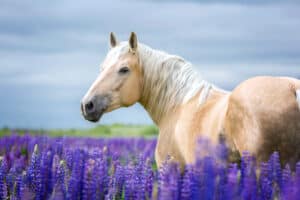The biggest horse ever recorded was Sampson, who was from the Shire breed. He weighed an astounding 3,359 pounds and stood over 22 hands tall when he measured in 1859. The tallest horse alive as of 2021 is Big Jake, who measures over 22 hands tall. Big Jake, who is a Belgian, weighs in at 2,260 pounds. His owners have to constantly put him on a diet so that his joints can withstand his weight. Animals were added to this list based on their height and weight. Learning more about these animals that are giant in size, especially in height and weight, is a fun activity.
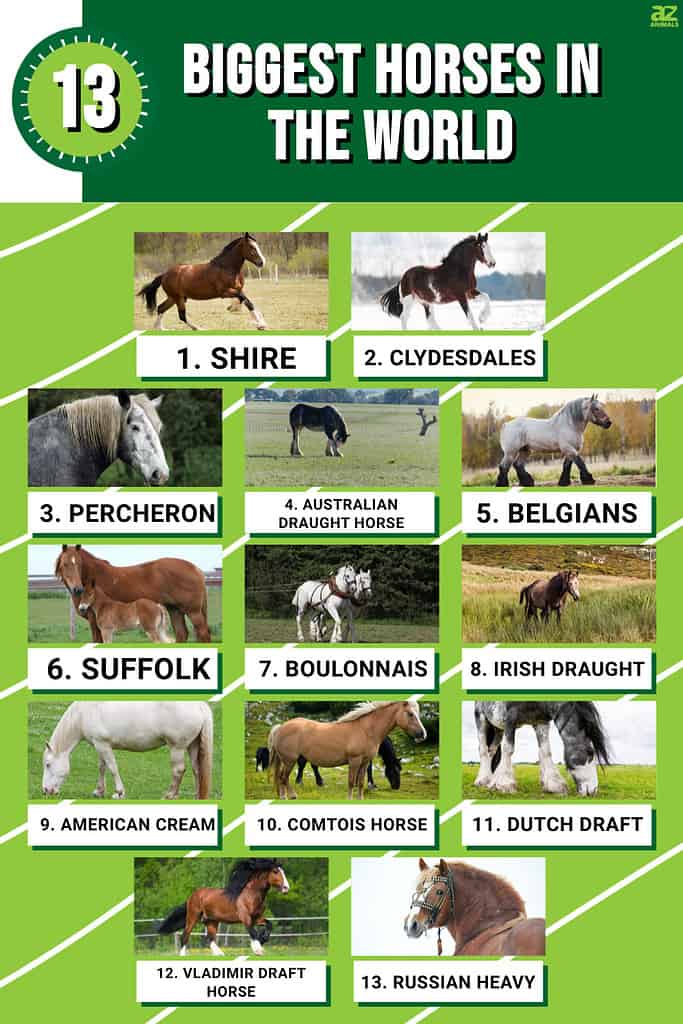
#13 Biggest Horses: Russian Heavy – 58 Inches Tall and 1,420 Pounds

©arthorse/Shutterstock.com
The Russian heavy has very short legs compared to many other draft breeds designed to give it better traction. Equestrians developed this breed in Russia in about 1952 can still be seen pulling wagons around the countryside.
This breed weighs about 1,420 pounds. It stands about 58 inches tall. Strawberry roan, bay, and chestnut are standard colors.
#12 Biggest Horses: Vladimir Draft Horse – 58 Inches Tall and 1,580 Pounds
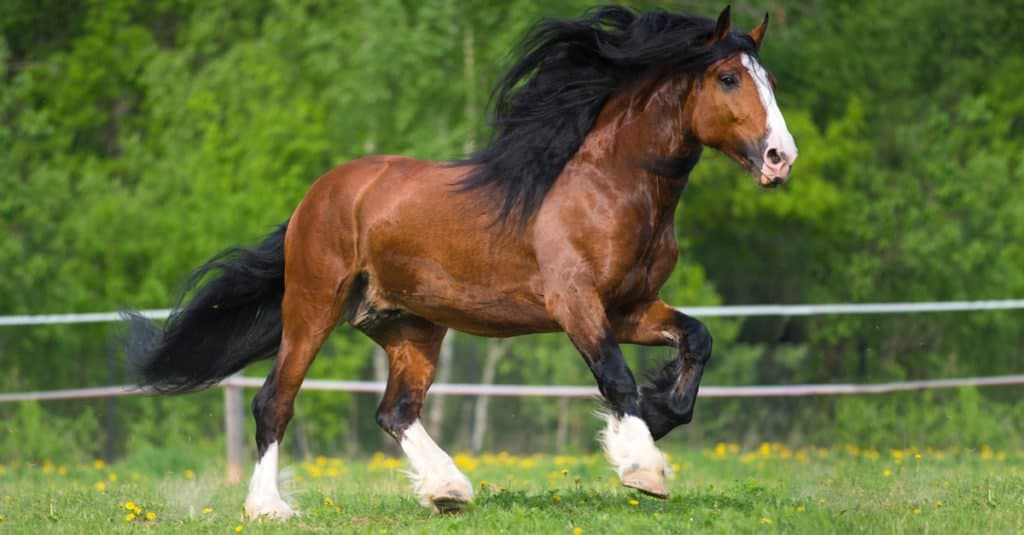
©Makarova Viktoria/Shutterstock.com
The Vladimir draft horse received recognition as a breed in 1946. Breeders developed this breed to pull their Vladimir Trokia sleighs through the snow. These animals usually have four white feet with feathering. While the bay is most common, you can find this animal in all colors. They are still often driven in teams of three to pull sleighs for Russian tourists.
The Vladimir draft horse stands 58 inches tall and weighs about 1,580 pounds. They often have Roman noses. The rear end is usually short and extremely powerful. Their tail is set higher up than on many draft animals.
#11 Biggest Horses: Dutch Draft – 62 Inches Tall and 1,500 Pounds
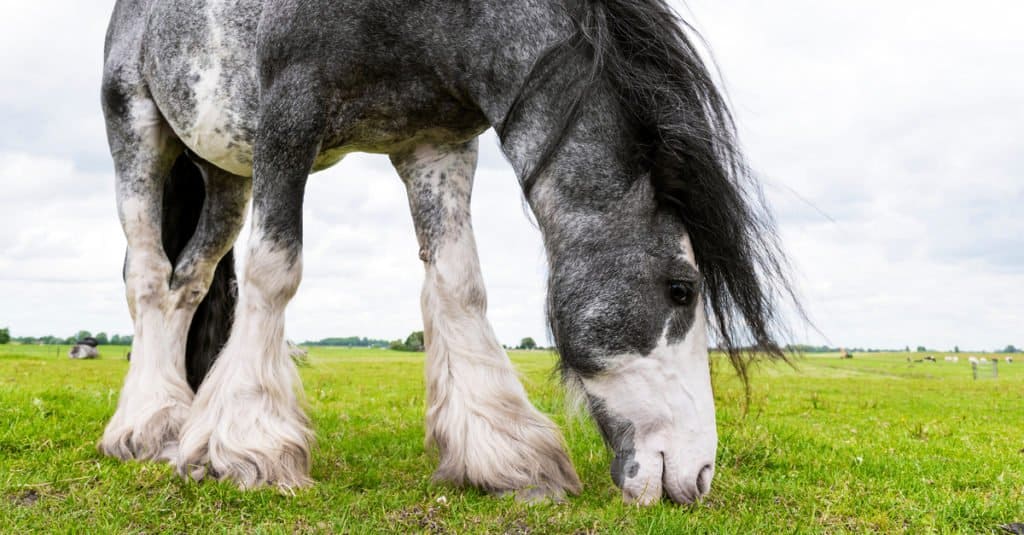
©Serhii Milekhin/Shutterstock.com
Dutch breeders created the Dutch Draft horse from local stock shortly after World War I. This cold-blooded horse moves exceptionally well for its size. These animals can be bay, black, grey, or chestnut. While their initial purpose was to help with logging and farming, they are mainly shown at shows today.
The Dutch draft horse stands about 62 inches tall and weighs about 1,500 pounds.
#10 Biggest Horses: Comtois Horse – 60 Inches Tall and 1,580 Pounds

©Luka Dakskobler/Shutterstock.com
Bred in the Jura Mountains between France and Switzerland, Comtois horses have extremely muscular hindquarters. They also have light feathering around their short legs. They can be any color, with most having a silverish tint.
Experts believe this breed could have possibly been bred in other areas of France since the first century. Breeding in the Jura Mountains started in the fourth century. These animals stand about 60 inches tall and weigh about 1,580 pounds.
#9 Biggest Horses: American Cream – 62 Inches Tall and 1,800 Pounds
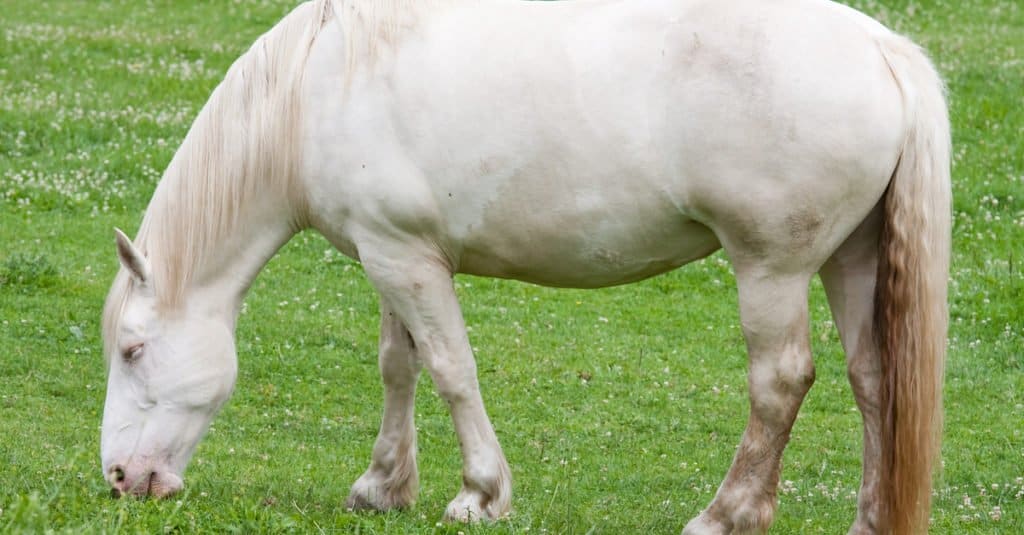
©Nancy Kennedy/Shutterstock.com
If you could travel back to Iowa in the 1850s, you might see a farmer auctioning off a cream draft animal called Old Granny in Melbourne. She is the foundation dam for all American cream horses. This breed is the only cold-blooded breed developed in the United States. All animals of this breed are a solid cream or palomino color.
American creams stand about 62 inches tall. Typically, mares weigh between 1600-to-1800 pounds while stallions weigh between 1,900-and-2,000 pounds.
#8 Biggest Horses: Irish Draught – 64 Inches Tall and 1,400 Pounds
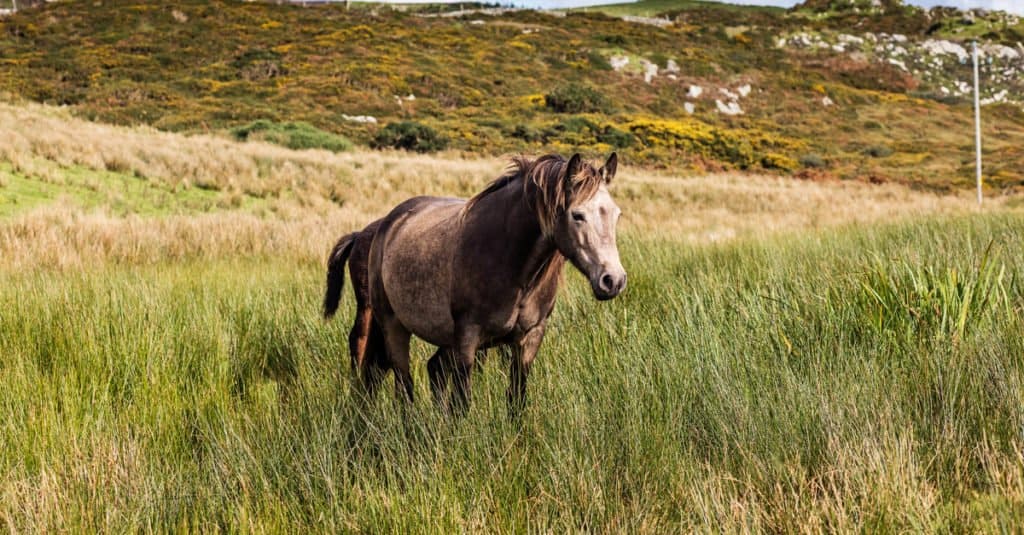
©Bartkowski/Shutterstock.com
The Irish draught was developed in Ireland during the 18th century to be strong enough to work on a farm and limber enough to make a great riding animal. While gray and chestnut are the most common, these animals come in various colors. Excessive white above the knees is considered a fault.
This breed often lives to be over 30 years old stands about 64 inches tall and can weigh over 1,400 pounds.
#7 Biggest Horses: Boulonnais – 64 inches Tall and 1,320 Pounds

©Bildagentur Zoonar GmbH/Shutterstock.com
The Boulonnais, also called white marble horse, was bred in France. There are at least three variations of this animal that soldiers initially bred before the Crusades, the present-day Boulonnais takes its size and heaviness from those developed last to aid in farming. This animal has a great temperament, which makes it suitable for lots of different things.
The Boulonnais stands about 64 inches tall and weighs about 1,320 pounds.
#6 Biggest Horses: Suffolk – 66 Inches Tall and 1,800 Pounds
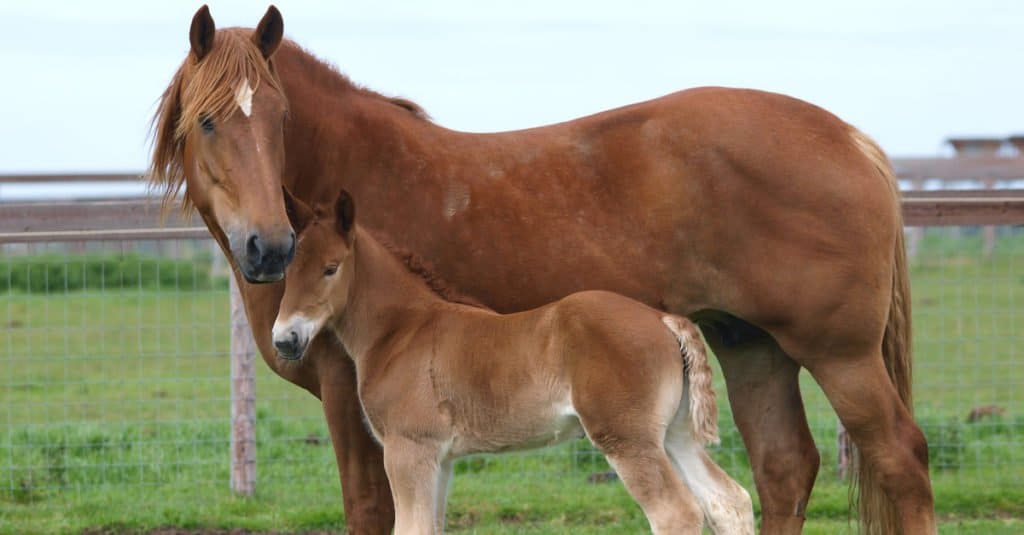
©iStock.com/nigelb10
Farmers developed the Suffolk horse exclusively for farm work in Suffolk and Norfolk, England. All Suffolks trace their lineage back to Crisp’s Horse of Ufford, who was foaled in 1768.
These animals are chestnuts. They stand about 66 inches tall with a rounder appearance than larger draft animals. They weigh about 1,800 pounds. They have very powerful rear legs.
#5 Biggest Horses: Belgians – 67 Inches Tall and 1,763 Pounds

©OlesyaNickolaeva/Shutterstock.com
Breeders first created the Belgian draft horse from Braban draft horses in Belgium. Most Belgians in the United States are lighter than those found in Belgium and surrounding countries. While most Belgians in the U.S. are chestnut with a flaxen mane and tail, other colors are equally acceptable both in the U.S. and overseas. These animals are often used in heavyweight pulling contests as they are some of the strongest draft horses.
Big Jake is a Belgian draft horse. Another large draft horse was Brooklyn Supreme, who stood 78 inches tall and weighed 3,200 pounds.
#4 Biggest Horses: Australian Draught Horse- 68 Inches Tall and 1,980 Pounds
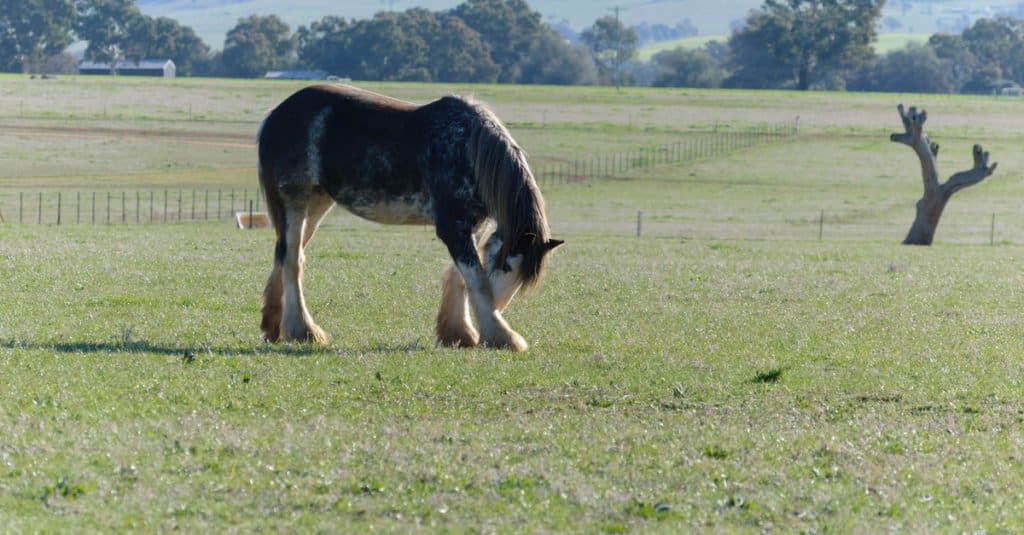
©iStock.com/lonewolfshome
Farmers developed the Australian draught horse in about 1850 as activity turned from prospecting to farming, and they needed a faster alternative than bullocks. These horses come in all colors. The legs have feathering. Breeders see excessive white markings as a fault because of Australia’s harsh weather.
No one developed a registration process for Australian draught horses until 1978. These horses stand about 68 inches tall and weigh about 1,980 pounds.
#3 Biggest Horses: Percheron – 68 Inches Tall and 2,200 Pounds

©slowmotiongli/Shutterstock.com
Farmers in the Perche province of France’s Normandy region originally developed Percherons. Horses of this breed in the United States are usually a little taller than those bred in France. The French government still actively breeds this horse, and they often cross it with lighter breeds to make dressage horses.
In France, all registered Percherons must be gray. In other countries, such as the United States, you can find Percherons in any color. These horses usually stand about 68 inches tall and weigh 2,200 pounds. One of the tallest Percherons of all time was Dr. LeGear. These stallions stood 21 hands tall and weighed 2,995 pounds.
#2 Biggest Horses: Clydesdales – 68 Inches Tall and 1,907 Pounds

©OlesyaNickolaeva/Shutterstock.com
Arguably best known for their appearances in Budweiser commercials, Clydesdales are initially from Scotland. Soldiers wearing heavy armor rode them into battle along the Clyde River. You may often see them in parades, where people often fall in love with them for their leg feathering and high-stepping gait.
You can find Clydesdales in every color. Breeders see white around their feet and on their faces as desirable traits. These horses weigh about 1,907 pounds and stand about 68 inches tall. King Lear was one of the largest Clydesdales ever to live. He stood 82 inches tall and weighed 2,950 pounds.
#1 Biggest Horses: Shire – 68 Inches Tall and 2,200 Pounds
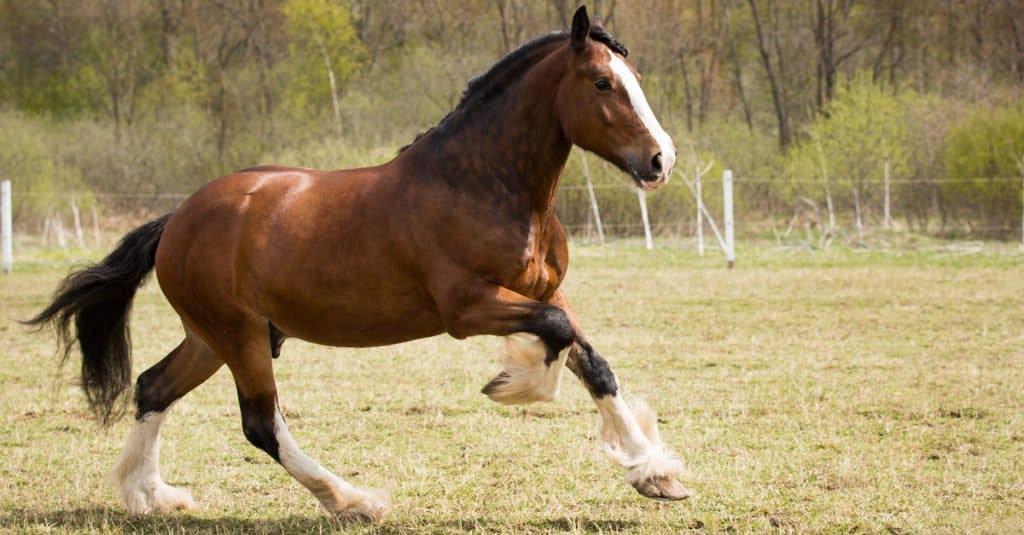
The Shire was originally bred to pull heavy carts of farms.
©Marina Kondratenko/Shutterstock.com
Sampson was a shire, and this British breed is known for producing huge horses. The average shire is 68 inches tall and weighs 2,200 pounds. Originally bred to pull heavy carts on farms, in breweries and coal mines, living history farms still use the shire.
They are commonly black, bay, gray, or brown, but they can be any color except chestnut. While a little white marking on the face or a front leg is not a fault, excessive white is not desirable. They have feathering around their legs.
Interestingly, European gypsies, in search of the perfect working horse that was strong yet easily manageable, bred shire horses together with Clydesdales (the second largest breed), Dale ponies, and Fell ponies. The result of this cross-breeding was the Gypsy Vanner horse.
With so many huge horses in the world, you will want to spend time learning about all of them. Some of these horses have a higher height while some have a higher weight. Many breeds almost died off when the world turned to machines to do work, but determined breeders worldwide worked diligently to protect them. Therefore, most have made an incredible comeback.
The Biggest Horses in the World vs the Smallest
Now that we’ve had a close-up look at the largest horses in the world, you may be wondering what kind of horses are the smallest. Here’s a list of the 8 smallest horses on Earth:
- Peabody–16.5 inches
- Falabella–34 inches
- Guoxia–40 inches
- Shetland Pony–46 inches
- Yonaguni–47 inches
- Noma–55 inches
- Icelandic Horses–56 inches
- Fjord Horses–60 inches
Summary of the 13 Biggest Horses in the World
Here’s a recap of the 13 largest horses that live on Earth:
| Rank | Horse | Size |
|---|---|---|
| 1 | Shire | 68 Inches Tall and 2,200 Pounds |
| 2 | Clydesdale | 68 Inches Tall and 1,907 Pounds |
| 3 | Percheron | 68 Inches Tall and 2,200 Pounds |
| 4 | Australian Draught | 68 Inches Tall and 1,980 Pounds |
| 5 | Belgian | 67 Inches Tall and 1,763 Pounds |
| 6 | Suffolk | 66 Inches Tall and 1,800 Pounds |
| 7 | Boulonnais | 64 inches Tall and 1,320 Pounds |
| 8 | Irish Draught | 64 Inches Tall and 1,400 Pounds |
| 9 | American Cream | 62 Inches Tall and 1,800 Pounds |
| 10 | Comtois | 60 Inches Tall and 1,580 Pounds |
| 11 | Dutch Draft | 62 Inches Tall and 1,500 Pounds |
| 12 | Vladimir Draft | 58 Inches Tall and 1,580 Pounds |
| 13 | Russian Heavy | 58 Inches Tall and 1,420 Pounds |
The photo featured at the top of this post is © Anaite/Shutterstock.com
Sources
- The Livestock Conservancy, Available here: https://livestockconservancy.org/index.php/heritage/internal/suffolk
- GlobeTrotting, Available here: https://www.globetrotting.com.au/horse-breed-dutch-draft/
- Wikipedia, Available here: https://en.wikipedia.org/wiki/Russian_Heavy_Draft
FAQs (Frequently Asked Questions)
What is the difference between a Shire Horse and a Clydesdale
The secret to telling one of these massive workhorses from the other is their coat markings. The Clydesdale has distinct white markings over the entire body and white hairs scattered throughout the coat. The Shire horse is mostly one solid color with white markings centered on the legs and face. However, this isn’t the only difference between Shire horses and Clydesdales.
Thank you for reading! Have some feedback for us? Contact the AZ Animals editorial team.





